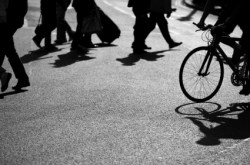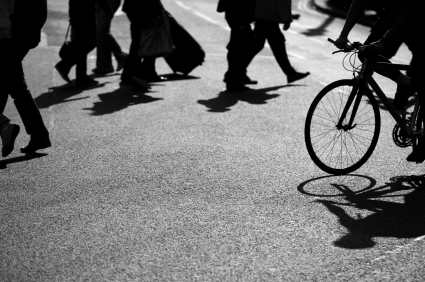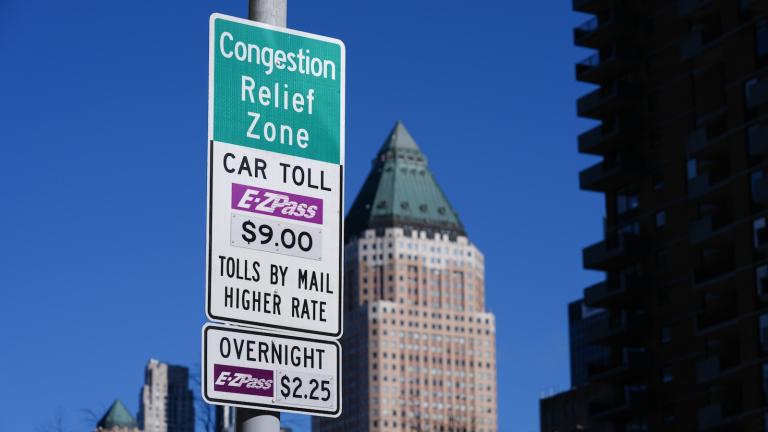 A few weeks ago, just outside of Washington, D.C., a woman was hit and killed by a man on a bicycle while walking on a paved multi-use trail, aka a “bike path.” It was a tragic accident. My heart goes out to any and all that knew and loved her. It also distressed me to read the anti-cyclist reaction in the comment sections of local online news sources and neighborhood forums, when all of this could have been avoided with a few simple precautions.
A few weeks ago, just outside of Washington, D.C., a woman was hit and killed by a man on a bicycle while walking on a paved multi-use trail, aka a “bike path.” It was a tragic accident. My heart goes out to any and all that knew and loved her. It also distressed me to read the anti-cyclist reaction in the comment sections of local online news sources and neighborhood forums, when all of this could have been avoided with a few simple precautions.
When various news sites reported the story online, the comments were predictably absurd. There were all sorts of attacks on bikes that reflected more on anti-bike sentiment than on the incident in question. “The path is for everyone not a bunch of spandex wearing Armstrong wannabes,” wrote one commenter. A member of the Fairfax Underground forum posted a story about the incident under this headline: “Bicyclist Mows Down Old Lady and Kills Her.” “Kill all cyclists,” replied a second member, “problem solved.”
A little more attention to the specifics, and the authors of these remarks would have known how off-base they were. The bike rider in this incident was a man in his early 60s. He was riding an $88 department store bike, a NEXT Power Climber. I doubt that he was training for a race. He claims he gave both a ring of his bell and an audible, “on your left,” to the elderly pedestrian. But apparently the alert caused her to step in front of him rather than out of his way. The collision knocked her backward onto the pavement, according to the police report, where she struck her head.
Clearly, there are things both people could have done to avoid the accident. But it is largely the responsibility of bicyclists to avoid collisions like this. Bikes yield to pedestrians — even on bike paths. Just as downhill skiers are expected to anticipate and react to other skiers below them on the slope, it is the responsibility of the cyclist to avoid collisions and expect the unexpected when overtaking other trail users.
It is important to keep in mind that “bike paths” are generally not solely for bikes. They are shared spaces that usually accommodate an assortment of people on foot; runners, hikers, dog walkers, nannies pushing strollers, kids walking home from school. Then there are the rollerbladers, roller skaters, skateboarders, people with their dogs on those nearly invisible extendable leashes, power-walking moms with wild toddlers that should be on leashes, and a long list of other potentially menacing variables.
Bicyclists should act accordingly. Here are some things to consider:
- Be considerate of other trail users! Give the person you’re passing a warning either by bell or mouth — a gentle “on your left” usually does the trick. Give them a chance to react, then make a good, clean pass. Pay extra attention to small children and dogs.
- Travel at a reasonable pace. This is not the place to try to set the land speed record. Need a workout? Keep your chain out of the “big ring” and work on high cadence at lower speeds.
- Slow down in areas that are commonly occupied by slower-moving trail users. Knowing your trail allows you to know what to expect.
- Obey the traffic laws. Some multi-use trails have speed limits. Most intersect with roads. Be aware of car traffic when you encounter it.
What do these things tell us about the tragic incident outside of Washington? From the reports I read, this rider did everything he should have done. The police apparently agree; he is not being charged with any crime.
So while we are trying to educate cyclists on how to behave more safely on the bike path, why not give a few tips to other trail users?
- Be aware of other trail users by simply looking and listening. An occasional glance forward and an occasional glance backwards should tip you off that there is a cyclist approaching.
- Walk on the right-hand side of the trail. If walking in a group, don’t block the whole trail. Pinch in and walk single file when faster trail users approach. Glance back for approaching trail users before U-turning on the trail.
- Understand that the Bike Path is basically a roadway for bicycles and other trail users.
Which brings me back to all the hate that was unleashed on cyclists after the accident outside of Washington, D.C.
It intrigues me that there are so many people who are anti-cyclist. Do they feel this strongly about cars? Cars are bigger, heavier, and move faster. There are more cars than bike on the roads, and they kill more pedestrians. According to the National Highway Transportation Safety Administration [PDF], 4,280 pedestrians were killed in crashes with motor vehicles in 2010. Another 70,000 were injured. Statistics about pedestrians killed or injured in crashes with bikes are hard to find.
What so many people fail to understand is that most cyclists are hyper alert and super cautious. A collision on a bike, whether with a car or a pedestrian, puts the cyclist at risk.
And yet, when we see a tragedy like this, instead of viewing people on bikes as individuals, the haters have clumped a very complex subculture of many groups and subgroups into one simple identity — those evil “spandex wearing Armstrong wannabes.” They seem to love to take their show-and-tell experience of being buzzed by a cyclist as the general behavior of all cyclists.
In the end, it is a matter of common sense and common courtesy.
Is this accident a wake-up call for bicyclists to be more careful and more considerate? Yes, but this notion of being more considerate of others should apply across the board. It’s certainly something I would love to see from the car drivers as they approach pedestrians and cyclists on the road.



